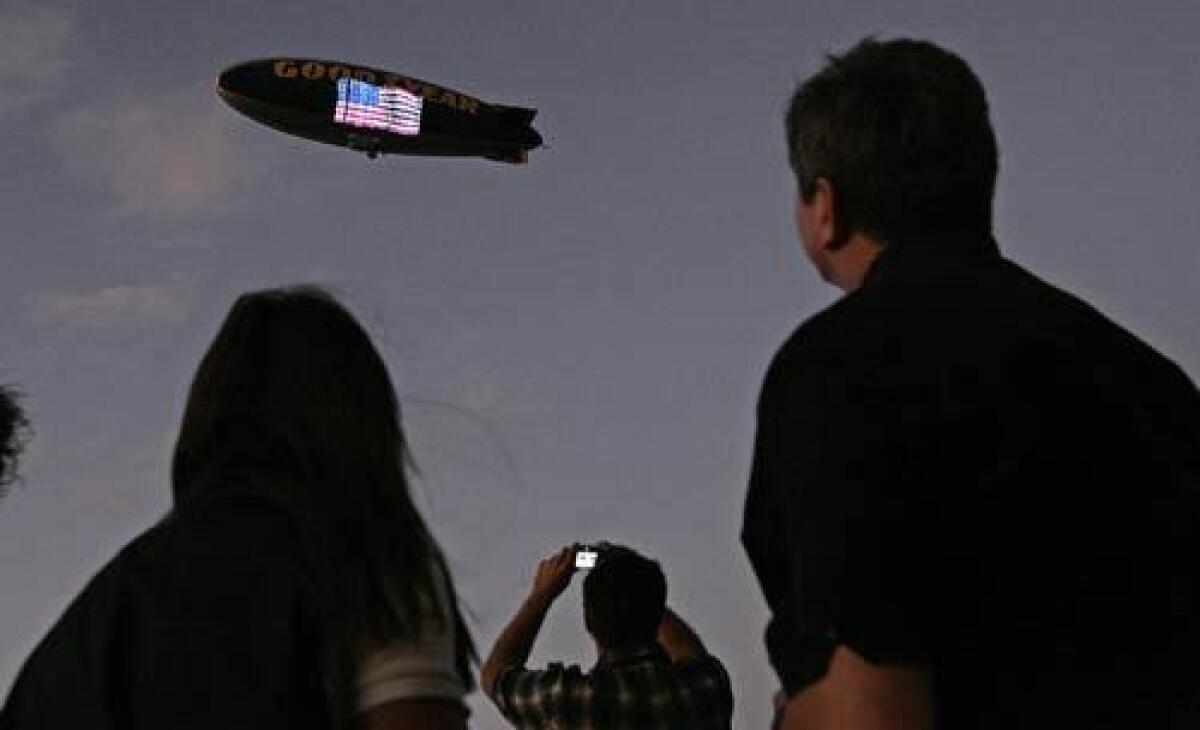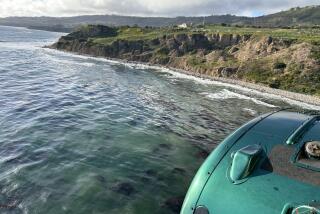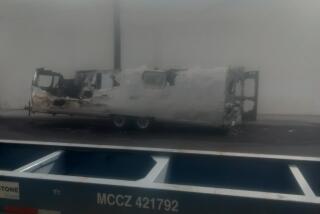Cleared for takeoff: Aviator’s friends give him a final farewell

They arrived for the memorial on a recent afternoon, filing in quietly under the steel trusses of a hangar, a motley crowd in suits, in flip-flops, in evening gowns, in pith helmets. Many were strangers to one another, their common thread a man named Griffith Lisle Hoerner. It felt, one said, like there was a hole in the sky.
The aviation community at the Santa Monica Airport is tight-knit and quirky, peppered with a few people who dabble in private jets and the other trappings of wealth, but far more “salty dudes,” as Hoerner’s son, Alex, describes them.
Some are eccentrics who are obsessed with the history of flight. They sit around debating whether ancient Peruvians might have figured out how to fly hot-air balloons. Some are pilots who are like barnstormers, meant to fly around wearing goggles and fluttering scarves.
It is an insular world and, for much of the last five decades, a ruddy, bearded adventurer known as “Griff” was a ringleader.
He was rated to fly just about anything: fixed-wing airplanes, blimps, helicopters, all manner of gliders and sailplanes. Around the airport, there were few more talented pilots; while Hoerner was not a cowboy, everybody seemed to have a story about his exploits.
There was the time he flew below sea level in Death Valley. There were the U-turns he made, tight and confident, below the rims of the Malibu canyons. The time he landed a helicopter on the Santa Monica Pier, dressed as Santa Claus. Once, he banked so sharply over Santa Catalina to photograph a bison that his friends thought he might tumble out of the plane.
He seemed invincible; he was, said an acquaintance, like a combination of Willy Wonka and Indiana Jones. Then, one day in October, his plane tumbled into the ocean, just past the breakers in Malibu.
The afternoon of Oct. 7, Hoerner took off from Santa Monica Airport with an experienced flight student named Mark Walker.
They were riding in a lightweight, Italian-made plane called a Sky Arrow 600 Sport, which featured a single “push-prop” behind the cockpit. There were two seats; Walker was in front and Hoerner was in the back, investigators believe.
A few years ago, the plane would have been classified as experimental. But the classifications have changed; the aircraft was listed as a “light sport aircraft,” which meant it was not built to standards as exacting as federal regulators expect of other aircraft.
Among other things, it had a three-point seat belt system instead of a sturdier five-point harness, according to the National Transportation Safety Board.
The plane was owned by a corporation that kept offices at the airport, and it was a popular rental for lessons. It was sleek and glassy; no one loved it more than Griff, said Randy Stein, 58, a friend for 20 years and one of his students for the last five.
“You always want to dance with the best-looking girl,” Stein said.
For Hoerner, a good day was any day spent in the air, but he found flying over the ocean to be particularly captivating.
Even if his schedule called for him to fly east, toward the desert, he would first zip over the sea. Still, he told his longtime companion and former wife, Suzy Giambattista: “Nothing would be worse than the impact of the ocean.”
“That is what he told me,” she said. “ ‘Nothing. Nothing. Nothing.’ ”
Just after 5 p.m., the plane was off the coast of Malibu. It took a hard left turn, then plummeted into the sea.
Michael Dwyer, 47, an executive at Jakks Pacific, the Malibu-based toy maker, was in a meeting. He heard the guttural whine of an engine and looked up.
“I saw a plane going absolutely nose-first into the water,” Dwyer said. “It hit like a huge bird, creating a huge splash. The wings popped right off.”
Dwyer shot up from his desk, shouting for someone to call 911. He raced outside, across Pacific Coast Highway, over a fence and across the beach. With a colleague, Jason Sandoval, he ferried two life preservers and a long surfboard toward the wreckage.
Hoerner and Walker were clinging to one of the wings, covered in blood. Dwyer and Sandoval eased them onto the surfboard and then onto a lifeguard’s boat. Walker’s injuries were serious but not life-threatening. Hoerner’s were severe.
For two weeks, Hoerner hung on at UCLA Medical Center. There were days when he seemed to be improving, when his breathing was less labored, when the pressure on his brain seemed to recede. But on Oct. 24, he died. He was 70.
The NTSB report could take six months, said Patrick Jones, a Los Angeles-based air safety investigator leading the probe. Investigators were able to haul the engine out of the ocean for tests; it ran fine and there is no reason to suspect malfunction, Jones said.
Back at Santa Monica Airport, that has raised more questions than it has answered.
“We’re all watching,” Stein said. “We all want to know.”
Last Sunday, Hoerner’s family and friends opened up Barker Hangar for a memorial. The invitation said “BYOP” -- bring your own plane. No one was sure what to expect; nearly 500 people showed up.
There were friends, students and fellow pilots. There were nurses who had cared for him in the intensive-care unit; the two men who helped rescue him from the ocean. Walker, who was in the crash, was there. (He declined to comment for this article.)
There were associates from Griff’s “day job,” running a small contracting firm. There were contacts from City Hall; Griff was involved in civic affairs and served as a liaison in recent years between pilots and residents pushing hard to shut down the airport because of noise and other issues.
There were people he’d worked with, for a long list of charities -- ferrying patients from remote areas to medical appointments; introducing teenagers to flying; preparing air transportation in the event of a major disaster.
There were his fellow nature lovers; Griff had become enchanted with the migration of monarch butterflies and had planted patches of “butterfly food” -- a type of milkweed -- around the airport and near his home in Santa Monica Canyon.
Everyone seemed taken aback by the size of the crowd.
“He had a wonderful life,” Stein said. “But nobody realized it until it was over.”
The attendees took turns at a microphone, swapping “Griffisms.”
Several remembered that in the 1950s, relatives had given him money for what he claimed were trumpet lessons. He was actually learning to fly.
His mother could not have been more surprised when a friend stopped her at the market to tell her that Griff had made an emergency landing on the beach north of Santa Monica. (Police were less impressed, citing Hoerner and a friend for illegal parking of a motor vehicle on a public beach.)
It was the kind of funeral that only good friends could throw -- toasting his flaws as well as his good traits.
Hoerner, they said, was genuinely interested in helping other people. He was also stubborn and occasionally grumpy, not to mention a questionable businessman who had a hard time keeping his insurance, his licensing and his bills straight.
Indeed, Stein said, his life was “a series of schemes,” all designed to convince someone richer than him that a particular plane needed desperately to be purchased -- and, of course, that he would have to test-fly it time and again.
“You always thought he was doing you a favor,” Stein said. “And he was having more fun than you ever had.”
Mostly, though, they just missed him and wondered what possibly could have happened up there.
“This was a guy who lived his life,” said Gene Evans, a friend for 30 years who once survived an emergency landing with Hoerner in a cornfield. “I feel sorry that he’s gone -- but it’s mostly sorry for me.”
Toward the end of the service, Hoerner’s pilot friends flew the Goodyear blimp over the hangar. Most cleared out to have a look.
Back inside the hangar, someone had parked Hoerner’s old, battered van and left the doors open. One of his books, a collection of Dorothy Parker poems, was in the back, open to page 14, to a poem called “The Trifler”: “Death’s the lover that I’d be taking; Wild and fickle and fierce is he.”
Gold is a Times staff writer.
More to Read
Start your day right
Sign up for Essential California for news, features and recommendations from the L.A. Times and beyond in your inbox six days a week.
You may occasionally receive promotional content from the Los Angeles Times.







